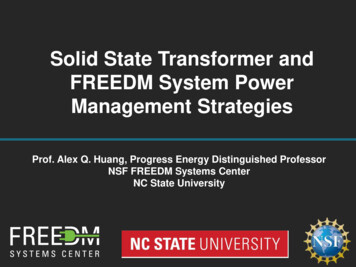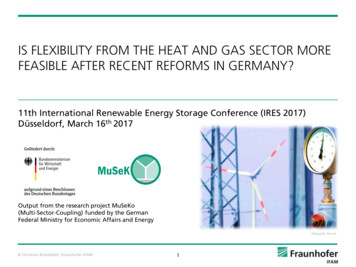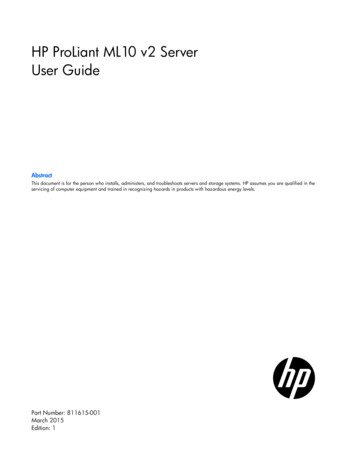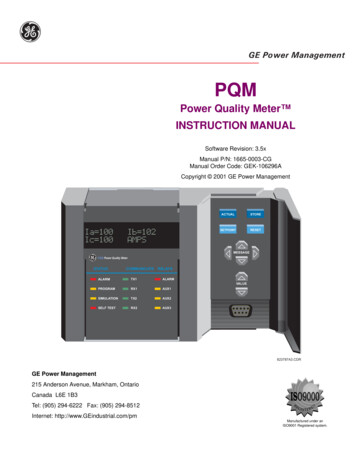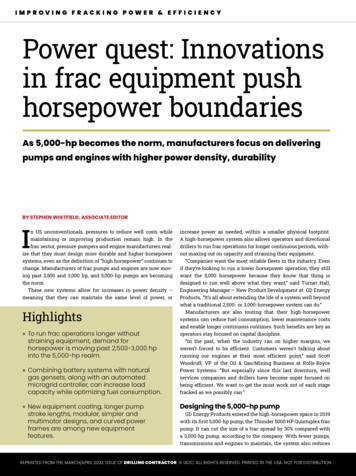
Transcription
IMPROVING FRACKING POWER & EFFICIENCYPower quest: Innovationsin frac equipment pushhorsepower boundariesAs 5,000-hp becomes the norm, manufacturers focus on deliveringpumps and engines with higher power density, durabilityBY STEPHEN WHITFIELD, ASSOCIATE EDITORIn US unconventionals, pressures to reduce well costs whilemaintaining or improving production remain high. In thefrac sector, pressure pumpers and engine manufacturers realize that they must design more durable and higher-horsepowersystems, even as the definition of “high horsepower” continues tochange. Manufacturers of frac pumps and engines are now moving past 2,500 and 3,000 hp, and 5,000-hp pumps are becomingthe norm.These new systems allow for increases in power density –meaning that they can maintain the same level of power, orHighlights» To run frac operations longer withoutstraining equipment, demand forhorsepower is moving past 2,500-3,000 hpinto the 5,000-hp realm.» Combining battery systems with naturalgas gensets, along with an automatedmicrogrid controller, can increase loadcapacity while optimizing fuel consumption.» New equipment coating, longer pumpstroke lengths, modular, simpler andmultimotor designs, and curved powerframes are among new equipmentfeatures.increase power as needed, within a smaller physical footprint.A high-horsepower system also allows operators and directionaldrillers to run frac operations for longer continuous periods, without maxing out on capacity and straining their equipment.“Companies want the most reliable fleets in the industry. Evenif they’re looking to run a lower-horsepower operation, they stillwant the 5,000 horsepower because they know that thing isdesigned to run well above what they want,” said Turner Hall,Engineering Manager – New Product Development at GD EnergyProducts. “It’s all about extending the life of a system well beyondwhat a traditional 2,500- or 3,000-horsepower system can do.”Manufacturers are also touting that their high-horsepowersystems can reduce fuel consumption, lower maintenance costsand enable longer continuous runtimes. Such benefits are key asoperators stay focused on capital discipline.“In the past, when the industry ran on higher margins, weweren’t forced to be efficient. Customers weren’t talking aboutrunning our engines at their most efficient point,” said ScottWoodruff, VP of the Oil & Gas/Mining Business at Rolls-RoycePower Systems. “But especially since this last downturn, wellservices companies and drillers have become super focused onbeing efficient. We want to get the most work out of each stagefracked as we possibly can.”Designing the 5,000-hp pumpGD Energy Products entered the high-horsepower space in 2019with its first 5,000-hp pump, the Thunder 5000 HP Quintuplex fracpump. It can cut the size of a frac spread by 30% compared witha 3,000-hp pump, according to the company. With fewer pumps,transmissions and engines to maintain, the system also reducesREPRINTED FROM THE MARCH/APRIL 2022 ISSUE OF DRILLING CONTRACTOR. IADC. ALL RIGHTS RESERVED. PRINTED IN THE USA. NOT FOR DISTRIBUTION.
IMPROVING FRACKING POWER & EFFICIENCYThe Thunder 5000 HP Quintuplex Pump, the first 5,000-hp offering from GD Energy Products, can reduce the size of a fracspread by 30% compared with a 3,000-hp pump. To compensate for the increased stress that a 5,000-hp pump places on itscomponents, the design features a longer stroke length and a harder lubricant to reduce scuffing and friction.potential points of failure at the frac site, minimizing the need formaintenance.“Your power density is greater when you run one 5,000-hppump versus two 2,500-hp pumps,” Mr Hall said. “Instead ofneeding 12 pumps on location, you only need six. That gets youefficiencies from a manpower and a safety standpoint. You havefewer pumps operating over a smaller area, so you’ve got less of achance for issues to pop up.”A 5,000-hp pump can also generate higher flow rates at equivalent pressures to a lower-horsepower pump, helping companiesboost production without increasing run time. Whereas runninga 3,000-hp pump at 12,000 psi will get you approximately 9.2 bbl/min, Mr Hall explained, running a 5,000-hp pump at the samepressure will get you 15.3 bbl/min.One of the bigger challenges in operating a 5,000-hp pump isthe potential for increased stress on the pump’s components. MrHall estimated that a typical 5,000-hp pump “essentially cuts inhalf” the life of its components when operating continuously atmaximum capacity. With that in mind, GD Energy Products prioritized durability in the design of the Thunder 5000 to ensure itcan have the same uptime as a lower-horsepower pump.To reduce scuffing, friction and adhesive wear, the companydeveloped a proprietary dry-film lubricant. The corrosion-resistant coating is harder and denser than the base steel used to buildthe frame of the pump, so it increases the load-bearing capacityof the bearings. The lubricant also helps prevent the pump fromoverheating when it operates at a higher horsepower.“When you’re going to a higher horsepower, it’s not necessarilyjust the stress of the components that you have to deal with butalso the speed at which that pump is turning,” Mr Hall said. “At5,000 horsepower, that pump is spinning faster than it traditionally has before, so you run the risk of a lot of heat generation. Thathas a big impact on pump performance. It was important for us toredesign our lubrication system so that we could pull that extraheat that’s generated by the faster speeds out of the pump.”The pump also features an 11-in. stroke length – the distancetraveled by each piston in an pump cycle – which is 3 in. longerthan the typical stroke length for a frac pump.The longer stroke length enables frac fleets to extend consumable life while delivering the same horsepower, pressures andflow rates but at slower speeds. While a shorter stroke lengthenables a pump to accelerate to full power faster, it also shortensthe life of the pistons, increasing the need for maintenance.Moreover, the new pump provides 37% more flow rate capacitythan a typical 8-in. stroke pump, which keeps both the pump’svelocity and pump speed lower. This, in turn, slows the accumulation of fatigue and consumable cycles, extending the life of thepump and consumable components while outputting more volume per revolution, according to GD Energy Products. “Essentially,this gets back to the total cost of ownership,” Mr Hall said. “WhereREPRINTED FROM THE MARCH/APRIL 2022 ISSUE OF DRILLING CONTRACTOR. IADC. ALL RIGHTS RESERVED. PRINTED IN THE USA. NOT FOR DISTRIBUTION.
IMPROVING FRACKING POWER & EFFICIENCYRolls-Royce Power Solutions’ MTU hybrid e-frac system features a modular design. Users can customize the system with anycombination of the company’s battery storage systems and natural gas generators to suit the specific power needs of a fracoperation. The battery systems also feature a proprietary microgrid controller, which automates the coordination of energystorage and demand between the battery system and the generators.the savings really comes from is on the consumable in the fluidend. I’m getting 37% more work out of the 11-in. stroke than I amout of the 8-in. stroke.”During validation testing in 2019, the pump was subjected to a 2million cycle endurance test at a 250,000-lb rod load for the entiretest. After 450 hours of testing, the pump exhibited no cracks inthe frame, no bearing failures and minimal damage to the crossheads and general bearings. The pump is now commerciallydeployed in several basins across North America.Hybrid e-frac systemsRolls-Royce Power Solutions, through its MTU brand of powersystems, launched its hybrid electric fracturing (e-frac) powersolution in 2021. It integrates a natural gas reciprocating enginewith a battery energy storage system. Compared with a conventional turbine e-frac setup, this hybrid system can tailor operational needs based on the load requirements of a specific operation, allowing power to be utilized more efficiently.The system was also designed to be modular. Users can customize the system to generate as much, or as little, power as theyneed. Any combination of MTU’s EnergyPack battery storagesystems – which range in capacities from 70 kWh to 2,200 kWh –and natural gas generator set can be mixed and matched.Last year, Rolls-Royce used simulation software to highlight thepotential energy efficiencies possible with its hybrid e-frac setupversus a turbine e-frac setup. The company simulated a frac operation using a turbine setup with a baseline load of 18-20 Megawattselectric (MWe) and a peak demand of 20-21 MWe. It then simulated the same operation with a hybrid system using 10 2.5-MWegas gensets and two 2-MWe battery energy storage systems.The conventional e-frac setup with one gas turbine generatorwas only able to run between 50% and 65% load capacity duringthe simulated operation. On the other hand, the hybrid e-frac system was able to run at 80% capacity without needing to use all 10gensets – eight gensets ran throughout the simulation while twoserved as backups.REPRINTED FROM THE MARCH/APRIL 2022 ISSUE OF DRILLING CONTRACTOR. IADC. ALL RIGHTS RESERVED. PRINTED IN THE USA. NOT FOR DISTRIBUTION.
IMPROVING FRACKING POWER & EFFICIENCYAbove: To improve system durability, Liberty’s digiFrac electric pump features a power frame with a curved internal geometry that the company believes will improve laminar flowand reduce the risk of cavitation.Right: Liberty plans to commercially launch its digiFrac system later this year. The company believes the new technology can produce twice as much horsepower per unit as aconventional pressure pump, even as its multimotor designallows each motor to run at a lower horsepower.One of the keys to this increase in load capacity was the company’s proprietary microgrid controller, which is installed in thebattery energy storage system. Microgrids are small-scale localpower networks in which various energy sources and storagesystems are managed automatically through a master controller.The MTU microgrid automates the coordination of energy storage and demand between the battery system and the generatorsin the hybrid e-frac system, turning them on and off as needed tooptimize fuel efficiency and emissions.“Getting the engine to its optimal range is pretty simple withthe energy storage. We’re able to move the engine up to a moreefficient load management situation – when you’re going from50% to 80%, you’re generating more work per gallon of fuel fromthat engine,” Mr Woodruff said.He called the microgrid/EnergyPack combination a “whole newtechnology platform” in the e-frac space. Beyond the batteries, anEnergyPack houses an electronic control unit, transformers andcooling equipment, making it a self-contained energy storageunit. By connecting its control system to the MTU microgrid,users can ensure a continuous and efficient distribution of powerthroughout a frac run.“The automation feature helps us optimize fuel consumption,and that has other benefits when it comes to emissions and assetutilization,” Mr Woodruff said. “We’re creating a system wherewe have much more visibility to steer these efficiencies evenfurther.”Scan me to watch a video interview with ScottWoodruff about Rolls-Royce Power Solutions’ MTUe-frac.bit.ly/3IBJD6YREPRINTED FROM THE MARCH/APRIL 2022 ISSUE OF DRILLING CONTRACTOR. IADC. ALL RIGHTS RESERVED. PRINTED IN THE USA. NOT FOR DISTRIBUTION.
IMPROVING FRACKING POWER & EFFICIENCYField trials demonstratee-frac efficienciesSTEPHEN WHITFIELD, ASSOCIATE EDITORLast year, NOV conducted an eight-month field trial of itsIdeal electric fracturing (e-frac) technology across severalreservoirs in Texas and New Mexico. The tests, completedin collaboration with NexTier Oilfield Solutions, focused onmeasuring the efficiency gains that can be generated byusing an e-frac system. The tests also aimed to demonstratethat the Ideal technology can help operators maintain highhorsepower operations without putting excessive strain onthe frac motor.“What we wanted to focus on was, how do we harnessthe electrical capability in the e-frac system to drive betterfracturing performance, lower NPT and improve efficiencyon location?” said Travis Bolt, Product Development Managerand Head of R&D for Pressure Pumping Equipment at NOV.“The cost of fracturing continues to be high. We’re seeing anincrease in complexity around frac operations. We’re all converging on that question of, what’s the next step for fracturingequipment?”At the 2022 SPE Hydraulic Fracturing TechnologyConference in The Woodlands, Texas, on 3 February, Mr Boltdiscussed both the general efficiencies that can be realizedfrom an e-frac system, which uses a natural gas reciprocatingengine as its primary power source, as well as more specificfield testing results for the Ideal system.Control of equipment to improve reliability was a majorfocus of the field testing. This primarily involved examiningthe turndown ratios of the motors, or the ratio of a motor’sspeed relative to the base speed at which it can be operatedsafely at 100% torque without suffering thermal damage. Ane-frac system typically has a 100:1 turndown ratio, meaningthat it can operate safely at 100% torque while running at 1% ofits base speed. As an example, Mr Bolt noted that for an e-fracsystem nominally rated to run at 1,800 rev/min, a 100:1 turndown ratio means that the engine can operate safely at 100%torque while running at 18 rev/min.This ability to generate torque at low motor speeds meansthat operators can more easily apply torque in a controlledContinued on page 35At the 2022 SPE HydraulicFracturing Technical Conference on 3 February,NOV’s Travis Bolt discussedthe efficiency gains thatwere seen during field trialsconducted last year of thecompany’s e-frac system.Electric frac pumpsLater this year, Liberty expects to commercially launch a newelectric pump system featuring a multimotor design. The company says the digiFrac system will have twice as much horsepowerper unit than conventional pressure-pumping technologies.The system’s power frame is flanked on either side by a podhousing five individual electric motors, each of which can generateup to 400 hp continuously or 550 hp at peak. This design eliminatesthe transmission, drive shaft and pinion found in conventionaldiesel frac systems and replaces it with a planetary gear system.The planetary system utilizes a center gear – known as a sungear – that serves as the driver of the system. Three exterior gears– referred to as planets – rotate around the sun gear. Becausethe planet gears are evenly distributed around the sun gear, thesystem provides higher torque compared with the standard transmission used in a diesel frac system.Removing the transmission from digiFrac is an example ofimproving efficiency at the margins, said Ron Gusek, Presidentof Liberty. Shifting gears under load using a standard transmission introduces stress at potential failure points in a conventionalfrac pump, increasing the need for maintenance and decreasingruntime. “If you’ve ever driven a car with a manual transmission,shifting gears can be a little clunky. Every time you have to shiftgears, there’s a little shock to the system, and that vibration canbe hard on components,” Mr Gusek said. “When we’re changinggears on a frac pump, it’s no different. With an electric pump, wehave a smooth system where it’s quite literally turning a dial toramp up the speed of the pump.”With the 10 motors working in unison, each pump will produce up to 4,000 hp continuously, or 5,500 hp intermittently. Thisallows operators to remove up to 50% of their pumping trailers perapplication.Combining this level of output with tight packaging, whichis enabled by removing the transmission, provides substantialpower density on the well pad. The result is high horsepowerdelivered within a small physical footprint.“If you look at a traditional frac pump, you would see theradiator system at the front of the trailer, then a 12-cylinder dieselengine, then the transmission, and then the pump at the veryback. That entire assembly is around 45 feet long,” Mr Gusekexplained. “If you look at digiFrac, all you have are a pump andthe electric motors attached to the sides of that pump. The footprint for that 5,500-horsepower pump takes up a space of 8 by 13feet.” The footprint to deliver double the horsepower is effectivelyhalved, he added.Additionally, with 10 motors operating individually at a lowerhorsepower, the digiFrac system is better suited to maintain continuous high horsepower throughout a run, even in the event ofan equipment failure.“If you have one large motor running and something happensto that motor, you’re out an entire piece of equipment,” Mr Guseksaid. “But if we have 10 small motors and something happens toone motor? No problem. We still have nine more motors. That’spart of our whole design philosophy: What can we do to maximizeour equipment hours as much as possible with as minimum anamount of maintenance as possible?”REPRINTED FROM THE MARCH/APRIL 2022 ISSUE OF DRILLING CONTRACTOR. IADC. ALL RIGHTS RESERVED. PRINTED IN THE USA. NOT FOR DISTRIBUTION.
IMPROVING FRACKING POWER & EFFICIENCY“Since this last downturn, wellservices companies anddrillers have become super focusedon being efficient. We want to getthe most work out of each stagefracked as we possibly can.”- Scott Woodruff, Rolls-Royce PowerSolutionsTo improve system durability, the power frame was designedwith an internal geometry that improves its resistance to flex andwear. Instead of creating a bore that is full of straight lines, Libertydesigned it with curves from top to bottom and front to backto make the flow laminar and reduce the chance of cavitation.Cavitation occurs when small, liquid-free bubbles form withinthe liquid in low-pressure areas. When the pressure increases, thebubbles collapse and generate shock waves that gradually wearout the pump.The digiFrac system will utilize Rolls Royce’s MTU 2.6-MWegas generator sets as its primary power source, effectively creating a hybrid system. This will allow for emissions reductions– an estimated 25% in CO2 emissions compared with other offgrid power sources – due to the gensets’ high thermal efficiency,which helps reduce fuel usage.“Rolls-Royce has done a lot of work with us to understand howmuch fuel we were going to be consuming and how that wouldaffect the performance of the engine,” Mr Gusek said. “If we’re goingto deliver an electric frac fleet to a location for our customer, wehave to be confident that we’re going to dramatically reduce theemissions footprint over the best available technology. Gas turbinesare great at delivering a huge amount of power into a small package, but the natural gas engine offers that opportunity of deliveringan efficient footprint that is better than the best available.”Through a comprehensive testing program that included durability testing and four field trials completed in Q2-Q3 2021, thesystem registered approximately 1,500 hours of operation in theyard and on four pads – two in the Permian Basin and two in theDenver-Julesburg Basin. While Liberty has not released detailsfrom those field tests, it said results “affirmed confidence for commercial production.”In its Q3 2021 earnings call, Liberty had announced multi-yearagreements to commercially deploy the digiFrac technology in2022 with two of its field-trial partners. Then, in the most recentearnings call on 9 February, the company said it plans to startdeploying digiFrac pump systems into its frac fleets in early Q2this year. DCScan me to watch a video interview with Turner Hallabout GD Energy Products’ Thunder 5000 HP pump.bit.ly/35GhtsGContinued from page 34manner, progressively increasing it over a period of timeinstead of applying maximum torque all at once, which couldplace unnecessary stress on the motor and pump. It alsoallows users to increase pressure from the frac pump withoutoverstressing the system.The ability to apply torque in a controlled manner, combined with an electric motor’s ability to generate torque valuesgreater than 100% for short periods of time, can help minimizethe need for manual intervention on downhole issues. To demonstrate this capability with the Ideal system, one of the testsduring the field trials focused on stuck augers. A 12-in. augerwas run on a 45 angle with both the e-frac and a conventionalfrac system. Support testing prior to the field test showed thatthe motor required between 225% and 275% torque to break theauger free without manual intervention.Testers applied torque progressively to the e-frac system,reaching 260% torque in 3s. As a conventional diesel frac system is unable to attain that level of torque, manual interventionis typically required when the auger becomes stuck.By providing the ability to address a downhole issue withoutstopping operations, “we’ve prevented a person from havingto go out into the field and manually interact with a piece ofequipment,” Mr Bolt said.Another focus area of the testing was the process of converting raw fuel into energy applied at the wellhead, and itsimpact on horsepower and engine efficiency, defined as theratio of work performed to the heat provided by an engine.Electricity is subject to the Joule effect and magnetic lossesas it’s transported within a conventional system. These lossescan account for up to a 2.5% loss in overhead line transmission.Another loss in the electrical system is the inefficiency of thestep-up and step-down transformer, which typically rangesfrom 1% to 2%.An e-frac system can mitigate the losses typically seen ina conventional system, primarily because it consumes thesame amount of power as it generates, Mr Bolt said. NOV andNexTier found that an e-frac system powered by natural gasinternal combustion generators can achieve a 4% increase inefficiency over conventional systems.“With mechanical systems, we have to worry about the initial energy conversion process of diesel fuel into mechanicalenergy through a transmission, or through a pump,” Mr Boltsaid. “Typically, you have inefficiency at the generator source.You lose energy at the transmission due to magnetic losses,and then you have more inefficiency when you drop down intorque. But when we looked at the data from our tests, what wefound was that, due to the initial efficiency gains that you havewith natural gas-powered systems, we’re seeing an increasein efficiency versus a conventional system. In the world ofefficiencies, a 3-4% increase is a big deal.”NOV and NexTier have said they expect to deploy the Idealfleet in the first half of 2022. DCREPRINTED FROM THE MARCH/APRIL 2022 ISSUE OF DRILLING CONTRACTOR. IADC. ALL RIGHTS RESERVED. PRINTED IN THE USA. NOT FOR DISTRIBUTION.
Designing the 5,000-hp pump GD Energy Products entered the high-horsepower space in 2019 with its first 5,000-hp pump, the Thunder 5000 HP Quintuplex frac pump. It can cut the size of a frac spread by 30% compared with a 3,000-hp pump, according to the company. With fewer pumps, transmissions and engines to maintain, the system also reduces




